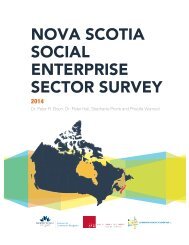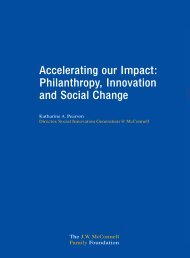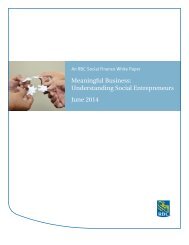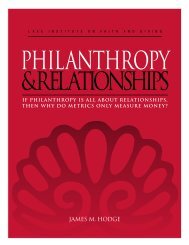Meaningful Business: Understanding Social Entrepreneurs June 2014
You also want an ePaper? Increase the reach of your titles
YUMPU automatically turns print PDFs into web optimized ePapers that Google loves.
RBC <strong>Social</strong> Finance<br />
<strong>Meaningful</strong> <strong>Business</strong> 14<br />
Meeting Challenges<br />
Unique Challenges of <strong>Social</strong> <strong>Business</strong>es<br />
Although social businesses tend to perform well across different management factors, the survey indicates that<br />
securing access to capital may be more challenging for social businesses than it is for other businesses. In part,<br />
there is a gap between the double bottom line philosophy and the criteria applied by investors and lenders<br />
when making decisions. In some cases, social businesses may want to invest in an initiative or product that does<br />
not have a proven path to payback. This could be a new market (e.g. renewable energy) or an unconventional<br />
approach to balancing business and social goals (e.g. a green loan). In either case, they require investors and<br />
lenders to share some affinity to their social goals, and put their faith in end customers to do the same.<br />
Quite often, social businesses offer products and services that require customers to pay a premium for<br />
goods or services that address a need in a more socially conscious way. For example, renewable energy is<br />
more expensive than conventional energy. A condominium built with state-of-the-art, eco-friendly building<br />
technology might be more expensive (at the point of purchase) than one built with conventional building<br />
technology. For this reason, social businesses need to identify niche markets that have both a functional<br />
need and emotional affinity to their products and services. This requires consultation and research to<br />
understand the needs of customers and track changing attitudes.<br />
“We had a consultation with 700 people in an arena, and we got a standing ovation for doing it,<br />
which doesn’t happen very often.”<br />
<br />
— Jeff Westeinde, Windmill Development Group<br />
Bullfrog Power, for example, regularly surveys customers and Canadians to track changing attitudes<br />
towards renewable energy. “We’re constantly tracking awareness of climate change and renewable energy<br />
and how Bullfrog contributes to that.” Similarly, Windmill holds public consultations to treat communities<br />
as genuine stakeholders in the development process.<br />
Using Creativity to Overcome Challenges<br />
During the interviews, a number of examples emerged of how social businesses were using creative solutions<br />
to overcome challenges, particularly related to financing.<br />
In some cases, business models might not fit conventional sources of financing. This has led some to find<br />
creative solutions to financing. For example, Windmill polled interested residents in a condo development<br />
in Calgary to determine whether they would be willing to pay more upfront for certain “green” technology<br />
that would yield a return of over 20% in operational savings, and the resounding answer was ‘no’. In the<br />
absence of financing mechanisms, they pioneered a “green loan” where they charged a standard fee based<br />
on operational savings until the loan was paid off.<br />
In setting up its enterprise, the Ottawa Regional Cancer Foundation is also exploring the use of a social<br />
impact bond for seed funding. They need to invest in technology (e.g. for online information tools and<br />
systems), but are not able to divert philanthropic dollars to fund the investment because of rules governing<br />
how donor contributions can be used.<br />
< Previous<br />
Back to Contents Next >







